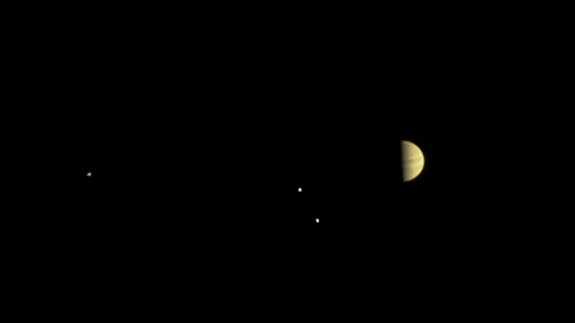This is what Jupiter sounds like

Jupiter's part of space is terrifying.
The largest planet in our solar system rotates so quickly that it actually flings charged particles, rock, ice and dust away from it at extreme speeds. Plus, the radiation surrounding the planet will fry any sensitive instrumentation near it in a matter of months.
Into this forbidding environment travels NASA's intrepid Juno spacecraft, which is set for a July Fourth rendezvous with the planet.
Thanks to new data the craft already sent back, scientists know that the huge planet's region of space even "sounds" different than the rest of the solar system.
SEE ALSO: NASA releases slick 360-degree trailer for its Juno mission to Jupiter
New videos from NASA use data collected by Juno about the space environment 5.56 million miles from Jupiter to create sound files. The high-tech transformation lets you literally hear the exact moment Juno passes into Jupiter's magnetosphere — the invisible bubble that demarcates the planet's magnetic part of space from the sun's.
These eerie sounds may not be what you would hear if you were passing into Jupiter's magnetosphere yourself, but it's a good representation of how even seemingly empty space is actually brimming with information if you know where to look.
"We can actually listen to what it's like to leave the sun and enter Jupiter," Juno principal investigator Scott Bolton said during a news conference on Thursday.
Juno is set to officially arrive at Jupiter on July Fourth, when it enters orbit around the huge planet. The spacecraft is designed to fly within 3,000 miles of the planet's cloud tops, gathering data about the world's interior potentially unlocking the secrets of how planets in our solar system formed billions of years ago.
But Juno didn't need to be in orbit around Jupiter to gather the plasma data.
On June 24, Juno crossed what's known as the "bow shock" separating the part of space dominated by solar wind streaming from the sun into the part of the solar system dominated by Jupiter's magnetic environment.
"The bow shock is analogous to a sonic boom," William Kurth, lead co-investigator for the Waves investigation on Juno that recorded and analyzed this data, said in a statement.
"The solar wind blows past all the planets at a speed of about a million miles per hour, and where it hits an obstacle, there's all this turbulence."
In the sound file, you can hear that turbulence as the higher frequency sound of the solar wind becomes lower as the spacecraft passed into Jupiter's magnetosphere.
This change in frequency happens because of the density of the particles surrounding Juno in the space environment.
Before entering Jupiter's magnetosphere, Juno was moving through the solar wind, which has about 16 particles per cubic inch, according to NASA, but that density decreased by about 100-fold when the probe passed into Jupiter's magnetic zone.
This reprieve won't last for long, however.
Scientists expect that Juno should start clocking higher densities of particles as it gets closer to Jupiter and farther into the gas giant's magnetosphere.
"If Jupiter's magnetosphere glowed in visible light, it would be twice the size of the full moon as seen from Earth," Kurth added.
Once in orbit, Juno should function for about 20 months before succumbing to the forces of Jupiter's radiation environment.
